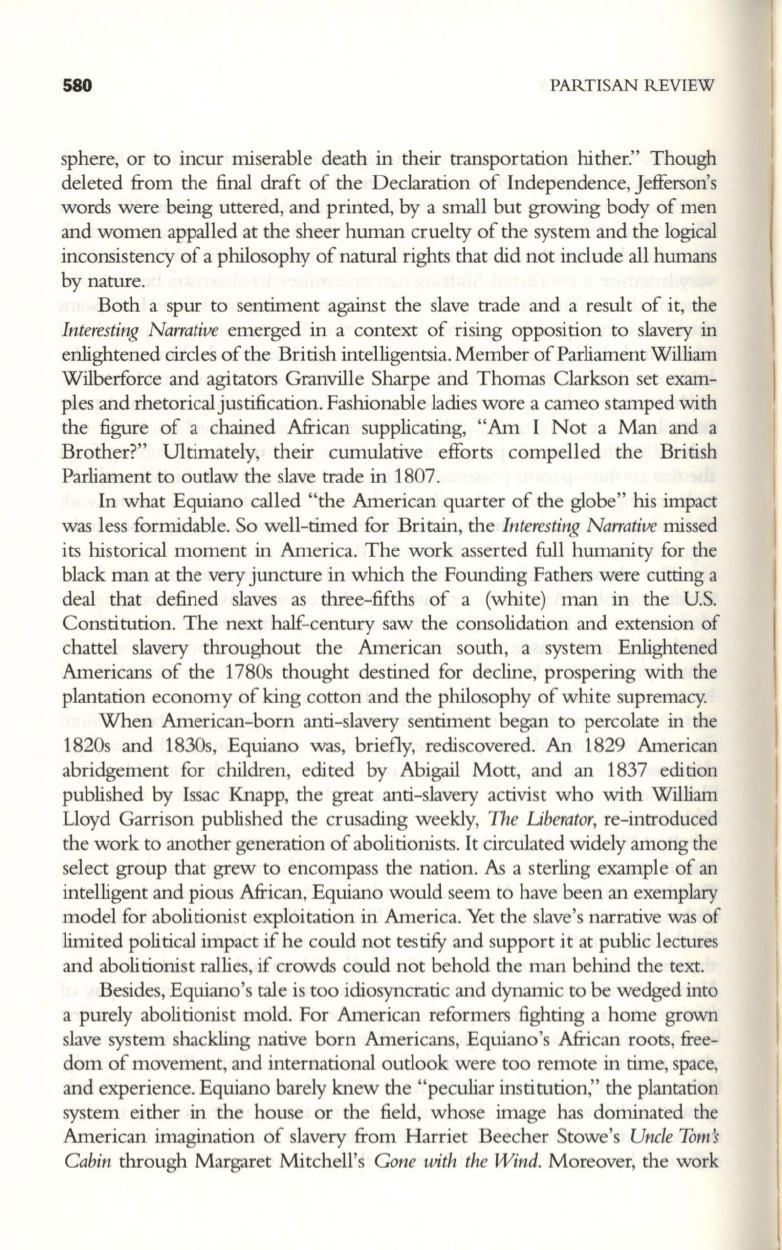
580
PARTISAN REVIEW
sphere, or to incur miserable death in their transportation hither!' Though
deleted from the final draft of the Declaration of Independence, Jefferson's
words were being uttered, and printed, by a small but growing body of men
and women appalled at the sheer human cruelty of the system and the logical
inconsistency of a philosophy of natural rights that did not include all humans
by nature.
Both a spur to sentiment against the slave trade and a result of it, the
Interesting Narrative
emerged in a context of rising opposition to slavery in
enlightened circles of the British intelligentsia. Member of Parliament William
Wilberforce and agitators Granville Sharpe and Thomas Clarkson set exam–
ples and rhetorical justification. Fashionable ladies wore a cameo stamped with
the figure of a chained African supplicating, "Am I Not a Man and a
Brother?" Ultimately, their cumulative efforts compelled the British
Parliament to outlaw the slave trade in 1807.
In what Equiano called "the American quarter of the globe" his impact
was less formidable. So well-timed for Britain, the
Interesting Narrative
missed
its historical moment in America. The work asserted full humanity for the
black man at the very juncture in which the Founding Fathers were cutting a
deal that defined slaves as three-fifths of a (white) man in the U.S.
Constitution. The next half-century saw the consolidation and extension of
chattel slavery throughout the American south, a system Enlightened
Americans of the 1780s thought destined for decline, prospering with the
plantation economy of king cotton and the philosophy of white supremacy.
When American-born anti-slavery sentiment began to percolate in the
1820s and 1830s, Equiano was, briefly, rediscovered. An 1829 American
abridgement for children, edited by Abigail Mott, and an 1837 edition
published by Issac Knapp, the great anti-slavery activist who with William
Lloyd Garrison published the crusading weekly,
The Liberator,
re-introduced
the work to another generation of abolitionists.
It
circulated widely among the
select group that grew to encompass the nation.
As
a sterling example of an
intelligent and pious African, Equiano would seem to have been an exemplary
model for abolitionist exploitation in America. Yet the slave's narrative was of
limited political impact
if
he could not testify and support it at public lectures
and abolitionist rallies,
if
crowds could not behold the man behind the text.
Besides, Equiano's tale is too idiosyncratic and dynamic to be wedged into
a purely abolitionist mold. For American reformers fighting a home grown
slave system shackling native born Americans, Equiano's African roots, free–
dom of movement, and international outlook were too remote in time, space,
and experience. Equiano barely knew the "peculiar institution;' the plantation
system either in the house or the field, whose image
has
dominated the
American imagination of slavery from Harriet Beecher Stowe's
Uncle
Torn~
Cabin
through Margaret
Mi
tchell's
Gone with the Wind.
Moreover, the work


